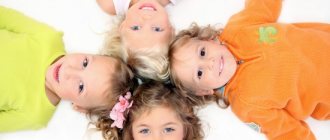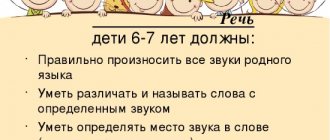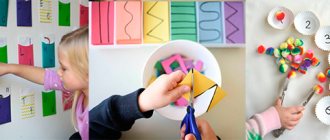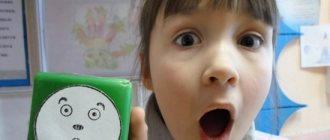The speech development of children 4-5 years old refers to the period of visiting kindergarten, when the child is actively learning about the world around him and relationships in society. It is a mistaken opinion that only a preschool institution should work with a baby, where he will be taught to draw, sculpt, and speak correctly. If parents want to have an educated child in the future who is interested in reading and has no speech problems, it is imperative to devote time to speech development at home. Additional activities will help prepare your child for school and facilitate the process of learning, reading and writing in the future.
Features of speech at 4-5 years old
By the age of 4, a child’s speech becomes more conscious and acquires contextual meaning. Before expressing a thought, the baby carefully thinks through what is said, determines when and what can be said. The act of speaking now depends on the society in which the baby is at the moment, on the context. The level of speaking increases as a result of studying and understanding the basics of the native language. The baby understands how to correctly express his own thoughts, how to logically construct a sentence.
By the age of 4-5 years, children’s speech changes, which is manifested in the following signs:
- The language is enriched, passive and active vocabulary is constantly increasing.
- The baby speaks more and more in sentences that are logically structured and rich in content.
- In a conversation, the baby operates with complex and compound sentences; his statements contain conjunctions, prepositions, and pronouns.
- The softened pronunciation of consonant sounds disappears, replacing whistling and hissing sounds.
- It becomes easier for the child to perceive sound speech by ear.
- The process of speaking is increasingly meaningful.
- The baby makes fewer abbreviations, omissions of words, substitutions, etc.
- The baby likes to sing songs, recite poems and fairy tales, and retell stories.
Teachers and speech therapists identify 10 main characteristics of speech related to developmental norms characteristic of 4-5 years:
- “Word creativity” is actively developing, the baby comes up with and invents his own words.
- Children can name the seasons, animals, and their babies.
- The vocabulary reaches 2000 words.
- In conversation, the baby uses pronouns, nouns, verbs, adverbs, participles, adjectives, conjunctions and prepositions.
- An understanding of the meaning of prepositions comes: in, on, for, in, before, etc.
- The baby can pronounce whistling and hissing sounds: Ts, Sh, Shch, Ch, S, Zh.
- Monologue speech appears.
- Sentences become richer: from 5 to 9 words.
- A child can recite a short poem by heart or retell a fairy tale with the help of an adult.
- Says actions during the game.
Norms of speech development for 4-year-old children
- The child uses words exactly according to their meaning.
- His vocabulary includes all parts of speech: nouns, verbs, adjectives, adverbs, pronouns and numerals.
- Able to describe a picture in 7-8 sentences.
- The baby is able to control the volume of speech.
- The speech has an expressive intonation.
- Correct speech rate.
- The child is able to learn simple rhymes and songs.
- The pronunciation of all sounds is correct, but problems may arise with l, r, sh, sch, ts.
Possible deviations
Modern kindergartens, as a rule, have speech therapists. The teacher diagnoses speech disorders when the child enters kindergarten and annually notes any changes. If there is a speech therapist in a preschool institution, the parent should go for a consultation and discuss the main points regarding the child’s speech development. A professional will tell you what sounds to pay attention to and whether there are any other problems when speaking.
If it is not possible to visit a speech therapist, you can identify problematic sounds in pronunciation at home. It is important that the baby does not guess about the diagnosis and perceives the process as a game.
The level of development of the speech apparatus can be checked using special exercises. Cards with animals, insects, pieces of furniture, dishes, etc. are suitable for diagnostics. Parents play with their child in kindergarten or school when the adult is a teacher or educator, and the baby is in class with other dolls. The teacher shows the card, the baby’s task is to name the drawn object. When pronouncing words, the adult pays attention to individual sounds, whether the baby clearly pronounces sonorous, hissing, and whistling sounds.
You can play the game “Who says what?”, when the parent names the animal, the baby tries to imitate it using his voice: mu-mu, beee, meow, woof, etc. The task is also to observe the pronunciation of individual sounds, to catch what emphasis should be placed on speech development.
The following problems and deviations may be observed in the development of speech in children 4-5 years old:
- Skipping and replacing individual sounds in a word: R with L, Ш with Ш, etc.
- Incorrect understanding of the meaning of words, poverty of active vocabulary.
- Rhythmic disturbances: stuttering, logophobia, prolongation or sudden cutting off of sounds.
- Incorrect sentence construction.
- It is difficult for a baby to retell a short story, even with the help of an adult, or to learn a short poem.
Separately, it is necessary to say about SRD (delayed speech development). The diagnosis is made when there are a combination of several disorders, falling behind WHO standards. If the reason lies in social factors, it is easier to correct the situation. Neurological problems will require medical and speech therapy assistance.
Speech development of a child at 3–4 years old: norms and features, recommended exercises
Oksana Belmas
Speech development of a child at 3–4 years old: norms and features, recommended exercises
At this age, children have already learned to think logically and draw their own conclusions about the objects they became acquainted with during play activities. The main feature of the speech development of 3-4 year old children is the ability to actively communicate with people. They speak even when it is difficult for them to pronounce sentences consisting of long structures. Difficulty pronouncing words (vowels, hissing sounds)
inherent in many children of this age, and therefore are not considered a deviation from generally accepted medical
norms . However, if there is a suspicion that speech skills are impaired , then you need to consult a pediatrician or speech therapist.
Features of speech development of a 3-4 year old child
The speech development of children 3 and 4 years old goes through certain stages of communicative communication. At first, the child learns speech with his parents, and then improves his skills in a preschool institution.
In the fourth month of life, many babies pronounce monosyllabic phrases well, and even learn to construct speech from complex sentences. It happens that it is very difficult to understand a baby, since speech functions are still poorly developed . This is especially noticeable when, while pronouncing words, a three-month-old child pauses , misses prepositions, and incorrectly puts endings or accents.
Characteristic features of the speech development of most children 3-4 years old, which are the norm , are the following indicators:
Many questions appear in the active vocabulary: why? For what? What will happen?;
boys and girls try to pronounce sentences consisting of 3-4 words;
Normally, a child’s vocabulary at age 3 is about 1,500 words, and at age four – more than 2,500 words ;
the child tries to remember and logically retell the sounds he heard, rhymes, nursery rhymes, and the speech of adults.
speech at 4 years old is constantly improving and becoming more understandable. He has already mastered enough grammar, composes phrases correctly and can even answer with a connected sentence without errors. More parts of speech and compound phrases appear. When speaking, adjectives, pronouns, prepositions and conjunctions are used. The articulation and use of verbs in numbers and persons improves noticeably.
Standards for children's speech development
The development of speech in children 3-4 years old within normal presupposes a clear understanding by mom and dad of their child . However, this indicator is purely individual. According to statistics, communication skills in most boys develop later than in girls. The delay period for personal skills can reach two to three months.
A child's speech apparatus develops as he grows up. It has its own characteristics , which depend on a number of factors - social, everyday and physiological. The first includes a good atmosphere in the family (no quarrels between parents)
and daily activities with the baby.
Physiological factors include peripheral and brain mechanisms. These speech centers are located in the cerebral cortex and store “
speech patterns ” that accumulate during the learning process.
Despite individual indicators, it is necessary to take into account generally accepted norms for assessing speech development in a 3-4 year old child . Parents' interest in ensuring that the child masters speech correctly will help avoid many obstacles in the future.
At 4 years old, a child’s speech must meet certain standards . Deviations from the norm in psychological development are possible , but not significant.
It is desirable that at this age the child should be able to:
tell about yourself (say first name, last name, residential address)
;
describe the proposed picture, retell your favorite “cartoon”
or a fairy tale;
accurately repeat words and sentences heard;
speak in lower and higher tones;
pronounce most sounds, with the exception of sonorants ( "r"
,
“l”
) and hissing (
“s”
,
“sh”
,
“sch”
);
understand well what is going on.
call the actions of pets - “the cat is lying”
,
"the dog barks"
.
If you find a discrepancy on several of the above points, seek help from your pediatrician. It is possible that the baby simply lacks parental support and attention, which is an obstacle to learning skills and abilities. If more serious disorders in delayed speech development , the doctor may prescribe a comprehensive examination for the child (psychiatrist, speech therapist, neurologist)
.
How to teach a baby to speak correctly?
Even when everything is fine with a 3-year-old child, his vocabulary needs to be constantly developed . To correct a child’s it is advisable to involve a speech therapist who will select the correct teaching method, taking into account his individual characteristics . Such trainings promote logical thinking and improve articulation.
The speech development of children at three years old proceeds in a dynamic form. During this period, it is very important to be extremely careful, not to rush to complicate classes, and soon your child’s speech development problems will be left behind .
What activities should be conducted with children at home so that they quickly master such skills? Children's speech therapists give several proven methodological recommendations :
Say all actions out loud. For example, “Anya goes for a walk outside”
,
“bring a warm blouse
,” or
. ”
Make adjustments to your speech. When communicating with your child, use different methods of intonation (loudness, intensity, prolongation)
.
Use didactic materials and speech therapy aids aimed at correcting speech disorders .
Teach your child to express his thoughts through communication. Try to gesticulate less when explaining new things.
Ask your little one to expressively voice his favorite characters ( “Teddy Bear”
,
“bunny”
,
“squirrel”
, girl
“Masha”
from the cartoon).
Strive to expand your vocabulary through tongue twisters and daily repetition of phrases. This will teach the child to speak better and remember more information.
Teach different forms of speech - from two-way dialogue to describing a specific object.
Follow the correct syntactic construction of sentences (number, case, gender)
.
During walks, give your child the opportunity to talk. Ask as many questions as possible, learn to answer subjects in detail . Give hints if he finds it difficult to answer. Reward good deeds.
A four-year-old child's speech should not be too loud or quiet. Try to teach him to talk at a certain pace and make sure that he doesn’t “jabber”
and didn’t mince words.
Fine motor skills help improve the functioning of brain centers and the pronunciation of related words. Let your child sculpt plasticine and assemble puzzles. Take him into the world of play activities, he will only benefit from this. Summarize the purpose of the objects: Paints and markers - they use them to draw, “shelves in the closet - they put children’s things on them.”
,
“from cups - they drink tea, milk and other drinks”
.
Constantly develop the organs involved in sound production (tongue, lips, facial muscles)
.
Speech defects in children can be corrected with the help of articulatory gymnastics. The main thing is not to oversaturate a 3-4 year old child with exercises .
Try to create a program in such a way as to break up classes to strengthen the articulatory apparatus over several days. Exercise with games
Everyone knows that games and toys are an interesting and exciting activity for many children. With the help of "fun"
The little preschooler trains memory, attention and learns to think logically.
During play activities, the child does not even notice how he independently develops speech , enriching it with new, more complex word forms.
It will be a plus if the parents of a 2-3 year old child help him in mastering vocabulary. A good example would be: reading books, learning poems or songs from cartoons. speech practice with other useful games and exercises , including:
Developing logic ." Arrange the pots and lids by size, from largest to smallest, let the baby learn to fold the “hats”
.
An exercise will help make him think when you need to subtract one unnecessary item from several items. For example, place 6 pencils and one felt-tip pen on the table, then ask: “What item would be extra here?”
No less useful for logical
development are activities in which the child learns to assemble construction sets, make sculptures, and combine objects by shape (rough, ribbed, smooth)
or common characteristics
(blue, red, yellow)
.
"Training your memory"
.
For example, this exercise : name with your eyes closed what is drawn on a piece of paper, and then indicate what changes have appeared in the picture (completed by one of the parents)
.
Another option is to let the child remember the toys laid out in front of him and turn away.
At this time, add one item and ask them to name it. During such activities, watch how he pronounces sounds and whether he distorts his speech. “Learning to use word forms correctly”
.
The goal is to use prepositions ( “on”
,
“under”
,
“before”
,
“about”
).
The game consists of moving objects and pronouncing their location. For example, “the cat is sitting on the table”
,
“the parrot flew into the cage”
,
“the baby fell under the chair”
.
An exercise for your child to guess objects will be useful .
From several toys, the mother chooses one and describes its characteristics, and the baby must guess what the story is about. " Exercises for the strength of voice pronunciation"
.
The goal of the game is to name objects expressively and loudly. You can train your voice power through role-playing games. Folk tales will be an excellent help here. Mom reads fairy-tale material ( “Masha and the Bear”
,
“The Frog Princess”
, changing the intonation and expressiveness of speech, then asks
the child to voice one of the characters.
Development of interactive speech . The purpose of the technique is to teach the child to build different coherent sentences. This can be achieved through direct communication with the baby, through detailed questions and answers ... It is easier for the child to build speech forms if he repeats the story after you. Ask questions more often: “what is he doing now”
,
“who says meow-meow”
,
“find the difference in the picture”
,
“what image does he see in the picture”
.
Children's speech must be developed consistently , taking into account their age characteristics and the level of general development of 3-4 year old children . All games played should not be complicated, so as not to tire or irritate the baby. It is advisable to send your child to kindergarten , where among peers, it is easier for him to develop speech skills and learn to speak correctly.
Reasons for violations
Children who cannot speak or have a limited vocabulary should cause concern for parents. It is necessary to show the baby to a neurologist, speech therapist, dentist, or orthodontist to determine the causes of silence or developmental delay.
A stimulating factor for a decrease in speech activity or its absence can be:
- An unfavorable speech environment when parents do not communicate with the baby, spend little time together, and do not read fairy tales and poems.
- Social environment, if parents have speech impairments, the child reluctantly adopts the style of speaking, copies adults, which develops into a habit that is difficult to get rid of with age.
- Problems from the field of neurology.
- Mental retardation, intellectual impairment.
- Problems with the organs of articulation (long tongue, high palate, malocclusion, frenulum defects).
Advice for parents and prevention of speech delay
Speech therapists give advice to parents on how to prevent developmental disorders at an early age, stimulate speech activity, and enrich the child’s vocabulary.
- Be sure to start communicating with your baby; the sooner this happens, the better. Psychologists talk about the importance of talking with a child during intrauterine development and immediately after birth with mom and dad.
- You need to read fairy tales to your baby, even if the adult thinks that the baby is not interested and does not understand anything. From the age of six months, it is recommended to tell children funny nursery rhymes, sing songs, and read rhymes during massages, walks, games, and gymnastics.
- Consult specialists (dentist, neurologist) in a timely manner to notice the problem at an early stage.
- Buy your child more educational games: puzzles, puppet theater, picture cards, kitchen modules. Do not leave the baby alone with toys, play with him, and actively involve him in conversation.
- Carry out articulation warm-ups with the baby, practice logarithmics, even if there are no obvious problems in speech.
- The fifth year for girls is interesting because active role-playing appears. You need to take advantage of this, play kindergarten, school, mother and daughter, etc. with your baby.
- Enrich the child’s inner and spiritual world: visit museums, circuses, performances.
The family plays the main role in the development of speech. If parents read fairy tales to their baby from an early age, tell rhymes, sing songs, talk about environmental phenomena, the baby will not have problems with active vocabulary.
Exercises and tasks
The main exercises and tasks that need to be done daily at home for the active development of coherent speech are:
Articulation gymnastics
- Eat some jam. You need to imagine that after eating the pie there is jam left on your lips that needs to be licked. Using your tongue, smoothly lick the jam from the lower and upper lips.
- Spade tongue. It is necessary to imagine that the tongue is a shovel, which should lie on the stand (lower lip) for as long as possible. We extend the tongue, placing it on the lower lip, and hold it in this position for 10-15 seconds.
- The tongue is a needle. You need to imagine that the tongue is a thin needle that needs to be held in place. We stretch out our tongue, trying to make it narrow, and try to hold it for 10-15 seconds.
- I'm a horse. The child needs to imagine himself as a horse that clatters its hoofs and clicks its tongue. We stomp our right and left feet in turn, clicking our tongue as we do so.
These exercises are best done for no more than 5-7 minutes and repeated 2 times a day.
It’s more fun to do articulation gymnastics with children by looking at pictures and reading rhymes.
Finger games
- Kitty. Both palms are clenched into fists and lie on a flat surface. It is necessary to simultaneously straighten the fingers on both handles, pressing them tightly to the table. The exercise must be repeated 4-5 times. After several lessons, the task can be complicated: first, the fingers on one hand are straightened, then they are compressed, and on the second they are straightened.
- Let's treat the cat with milk. Palms as if scooping out milk.
- Bunny. The fingers imitate the ears of a bunny, the fingers run along the table, clenched into a fist, fist in fist.
- Dog. The index finger shows the tail of the dog, the fingers are clenched into a fist, the thumb is raised up, the fingers run away.
Using finger games with parallel learning of rhymes can show quite good results, since there is a strong relationship between the human hand and the speech center of the brain. The baby easily and more emotionally perceives information and reproduces it in the future without problems.
Logorhythmics
Logorhythmics is the simultaneous reading of poetry, accompanied by a certain set of movements against the background of thematic music. Initially, the adult shows everything by example, after which the child is asked to repeat what he just saw.
The optimal time to complete this task is the second half of the day, the regularity of classes is every 1-2 days.
A special place in speech development classes is given to cartoons, which children love so much. There are specially designed cartoons aimed at reinforcing the letters of the alphabet, learning colors, learning to count and speech development.
The choice of cartoons remains up to the parents, but a prerequisite is its versatility (for both boys and girls), the presence of positive characters, and high quality video and sound.










